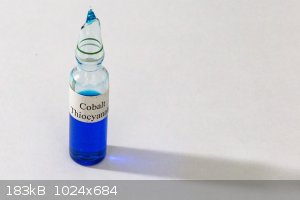Foeskes
Hazard to Others
  
Posts: 156
Registered: 25-2-2017
Member Is Offline
Mood: No Mood
|
|
Mysterious compound
Last week, I went to my local school supply store (they sell lots of chemicals there) and bought ammonium dichromate, the bottle looks like it has
been there for many years. After I got home and opened it, I found out that it isn't ammonium dichromate but a clear solid crystal that looks like
sodium thio sulfate when I poured it out a bit of liquid came too, so it's probably hygroscopic. It's a somewhat strong reducing agent reacting with
permanganate to form manganese dioxide and reducing hypochlorite with a exothermic reaction. However unlike thiosulfate it reacts with dilute sulfuric
acid to form a deep red compound (kinda like permanganate mixed with MnO2) with no gas produced it doesn't seem to be exothermic either.
What might this possibly be?
EDIT: it's likely thiocyanate, it reacts with iron(III) sulfate forming a blood red solution. Its dissolution is endothermic.
[Edited on 9-9-2017 by Foeskes]
[Edited on 9-9-2017 by Foeskes]
|
|
|
ave369
Eastern European Lady of Mad Science
   
Posts: 596
Registered: 8-7-2015
Location: No Location
Member Is Offline
Mood: No Mood
|
|
Is thiocyanic acid deep red? Or is it just iron contamination in sulfuric acid?
Smells like ammonia....
|
|
|
Foeskes
Hazard to Others
  
Posts: 156
Registered: 25-2-2017
Member Is Offline
Mood: No Mood
|
|
I'm starting to think its not it, since cobalt(II) is SUPPOST to make a blue compound but I got a deep red compound. The red also seems to have low
solubility in water.
|
|
|
nezza
Hazard to Others
  
Posts: 324
Registered: 17-4-2011
Location: UK
Member Is Offline
Mood: phosphorescent
|
|
It sounds like potassium thiocyanate. It is quite hygroscopic and old bottles will have liquid in them unless extremely well sealed.
If you're not part of the solution, you're part of the precipitate.
|
|
|
j_sum1
Administrator
       
Posts: 6229
Registered: 4-10-2014
Location: Unmoved
Member Is Offline
Mood: Organised
|
|
I would have thought ammonium thiosulfate was more likely -- at least a more likely mislabel.
You could test with NaOH to see if it is an ammonium salt. Maybe do a flame test if that comes up negative.
[Edited on 9-9-2017 by j_sum1]
|
|
|
Foeskes
Hazard to Others
  
Posts: 156
Registered: 25-2-2017
Member Is Offline
Mood: No Mood
|
|
Ok, I reacted it with NaOH. The reaction definitely produced ammonia.
Any more test for thiocyanate?
|
|
|
j_sum1
Administrator
       
Posts: 6229
Registered: 4-10-2014
Location: Unmoved
Member Is Offline
Mood: Organised
|
|
Well the rust-blood complex with Fe3+ is as far as I know unique. Nothing else reacts with ferric in that way.
Is it possible that your Co is impure and the normal colour is masked?
Edit
I note that Co(SCN)2 is a bright red colour. A (very) quick search gave me nothing on the complex. I think this means the puzzle is solved.
[Edited on 9-9-2017 by j_sum1]
|
|
|
nezza
Hazard to Others
  
Posts: 324
Registered: 17-4-2011
Location: UK
Member Is Offline
Mood: phosphorescent
|
|
Mix some of the solution 50:50 with acetone. Adding cobalt(II) to this solution should give a bright blue complex. Be aware that any iron(III)
contamination may mask the colour. Iron(III) can be removed by the addition of fluoride. Here is a picture of the cobalt(II) thiocyanate complex in
50% acetone.

[Edited on 14-9-2017 by nezza]
If you're not part of the solution, you're part of the precipitate.
|
|
|
woelen
Super Administrator
        
Posts: 7977
Registered: 20-8-2005
Location: Netherlands
Member Is Offline
Mood: interested
|
|
If you have access to nitrite, then you can check for thiocyanate as follows:
Dissolve some of the mystery solid in 10% H2SO4 (not HCl)
If it is a thiocyanate, then the solution remains colorless if the H2SO4 does not contain any iron(III).
Add a little amount of solid NaNO2 or a ml or so of highly concentrated NaNO2-solution.
If you have thiocyanate, then a deep red solution is obtained, which slowly decomposes, giving bubbles of gas and a white fume.
|
|
|